Family : Orchidaceae

Text © Prof. Pietro Pavone

English translation by Mario Beltramini
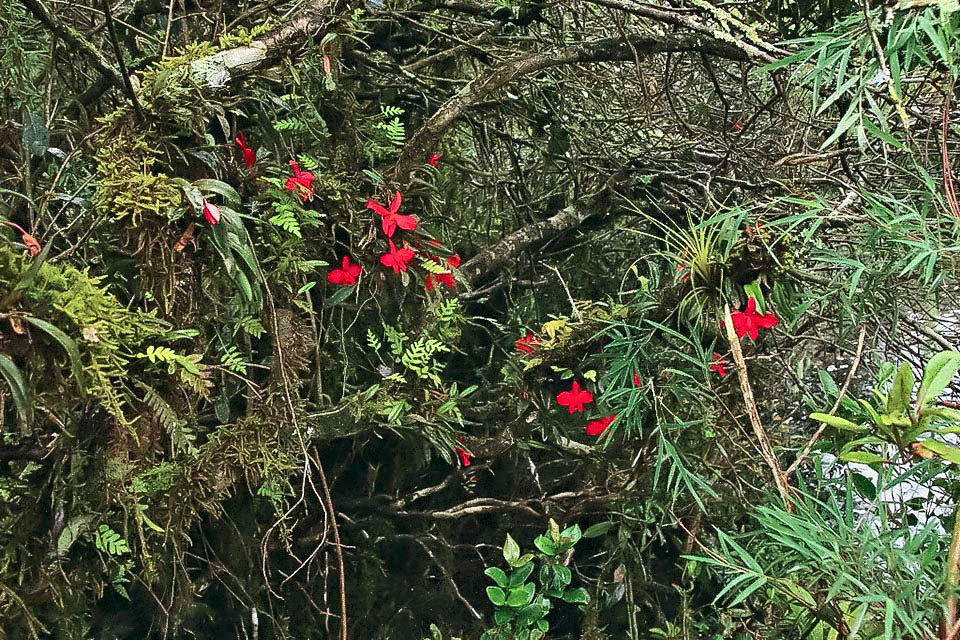
Cattleya coccinea is endemic to north-eastern Argentina and south and south-eastern Brazil, along the coastal mountain range of the Serra do Mar © Luiz Filipe Varella
Cattleya coccinea Lindl. (1836) is a species of the family Orchidaceae, subfamily Epidendroideae, tribe Epidendreae, subtribe Laeliinae.
Recent phylogenetic studies on the subtribe Laeliinae have radically changed the delimitation of the genus Cattleya to which have been included all the species of the genus Sophronitis and the Brazilian species of Laelia. As a matter fact, Cattleya coccinea was known as Sophronitis coccinea (Lindl.) Rchb.f. (1862), but it has been necessary to reclassify it according to the studies of molecular molecular phylogenetics.
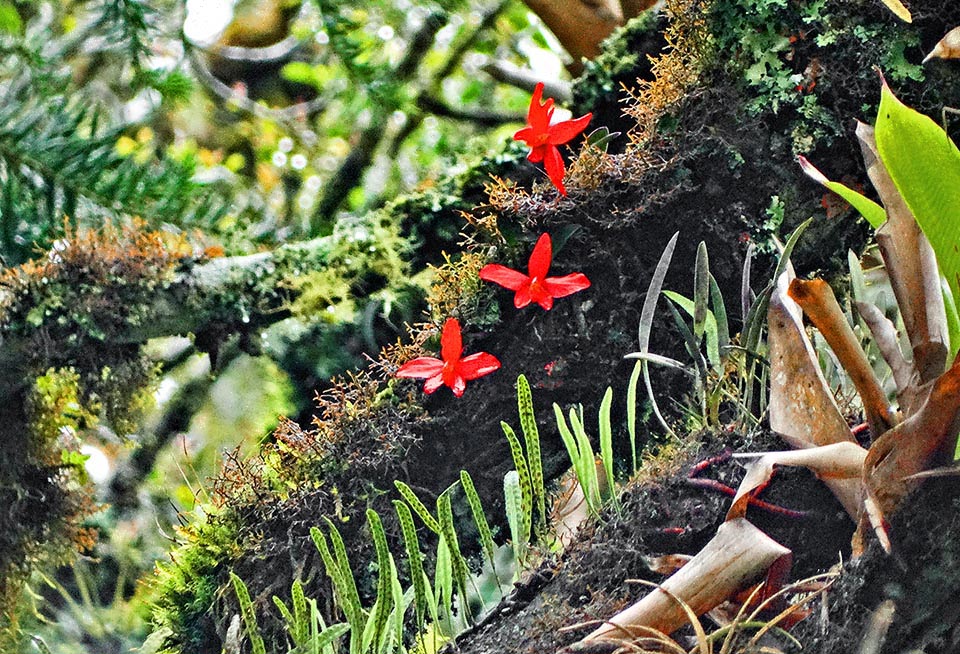
It’s a small rhizomatous orchid, epiphyte or lithophyte on mossy rocks, growing on the humd slopes facing the sea at 600-900 m of altitude © Eduardo Luis Masiero
Cassio van den Berg (Phytotaxa 2014, 186: 75-86) has subdivided the genus Cattleya into four subgenera (Cattleya, Cattleyella, Intermediae, Maximae), three sections (Cattleya, Crispae, Lawrenceanae) and five series Cattleyodes, Hadrolaelia, Microlaelia, Parviflorae, Sophronitis). According to this, Cattleya coccinea falls within the subgenus Cattleya section Crispae, series Sophronitis.
Cattleya coccinea is endemic to north-eastern Argentina and to south and south-eastern Brazil.
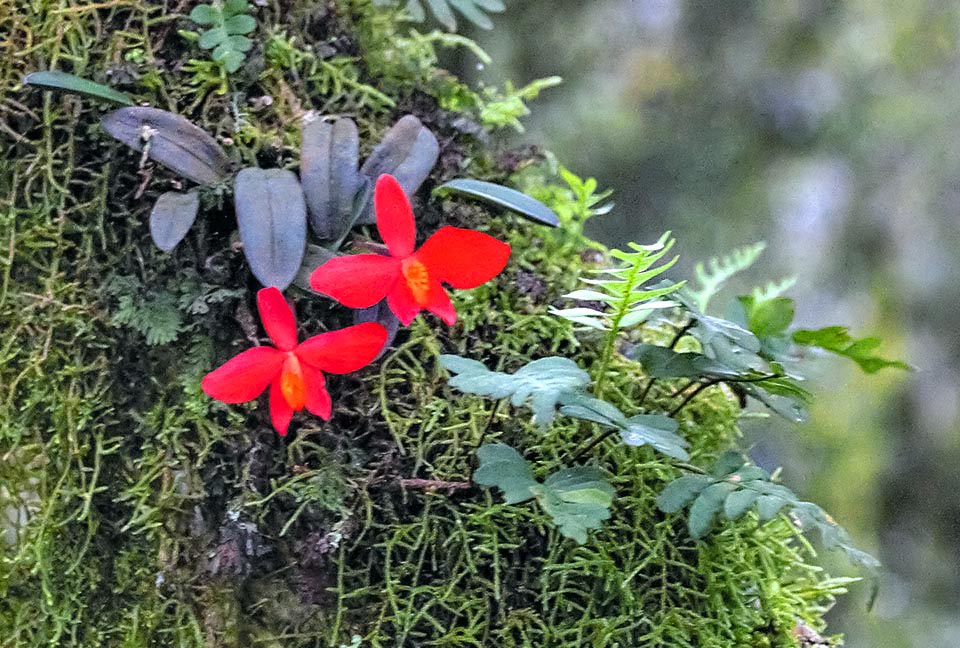
Cattleya coccinea doesn’t exceed the height of 10 cm. with close pseudobulbs, fusiform, each with only one about 6 cm long coriaceous leaf © Luiz Filipe Varella
Particularly, it is found in the states of Espirito Santo and of Santa Catarina, along the coastal Atlantic range of the Serra do Mar, where it grows as epiphyte on the trees of the coastal tropical forest (Mata Atlantica) and also as lithophyte on rocks covered by moss, from 650 to 1750 metres of altitude.
It is also present in the states of Rio Grande do Sul, Paraná, of São Paulo and of Minas Gerais, on the slopes facing the sea, in an about 3-5 km wide belt at altitudes between 600 and 900 m.
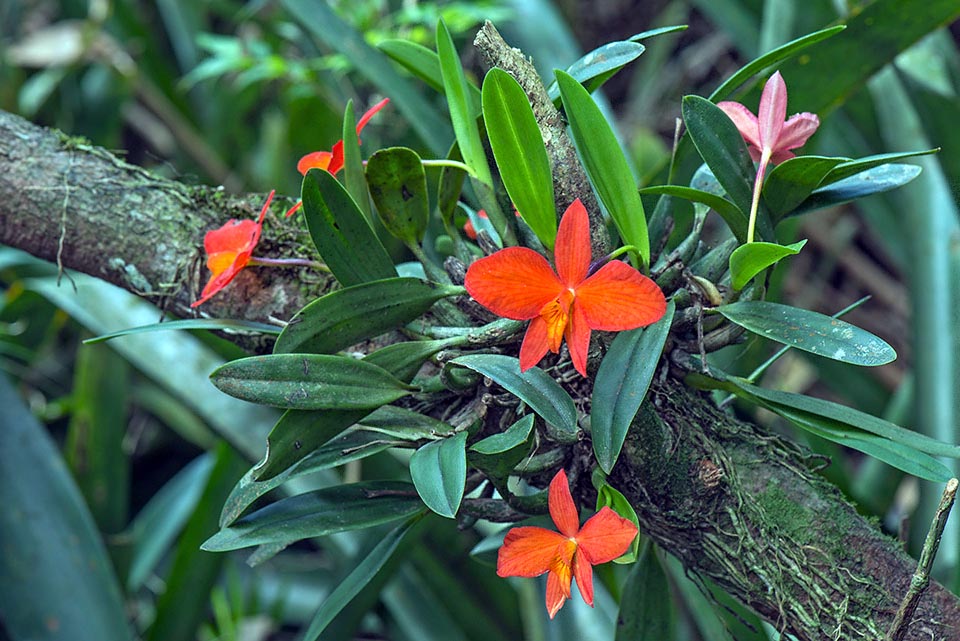
The flowers are pollinated by Chlorostilbon lucidus, a hummingbird attracted by the flower flamboyant in the forest greenery who however does not offer food in exchange © Howard Rice
In these areas the climate is very humid due to the southeast trade winds that raise along the walls of the mountains and condense in clouds with a thin rain similar to fog. Cattleya coccinea grows on the trees, usually 5-15 m tall, and with a diametre of the trunk of 10-30 cm, usually covered by moss from the ground up to almost the top.
Cattleya coccinea is a commercially protected species because it is at risk of extinction in nature and as such is inserted in the Appendix II of Washington Convention (CITES) whose aim is to protect the animal and vegetable species under risk of extinction, by preventing their export and detention.
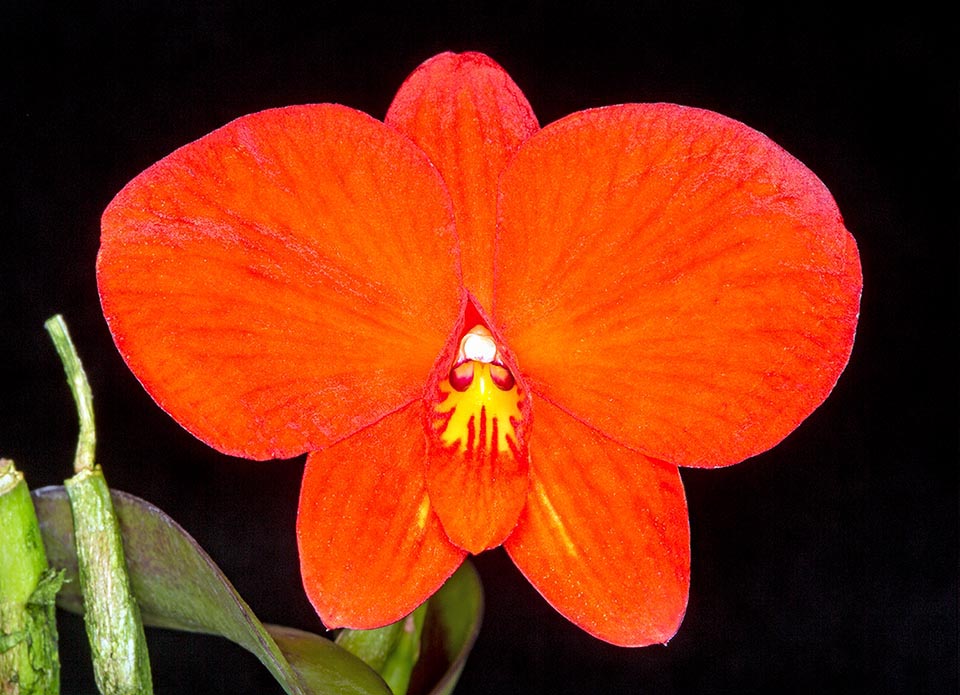
The unscented flower, 5-6 cm broad, has lively red rounded petals. The tubular labellum shows yellow-orange brushstrokes, with typical red lines © Giuseppe Mazza
The first specimen of the genus was collected in nature on the mountains not far from Rio de Janeiro and reached England in 1818 in the hands of Sir William Jackson Hooker (1785-1835).
He made the plant flower in his greenhouse in Suffolk, but did not describe the plant and did not publish anything about it.
Later on, Sir William Cattley (1788-1835), a patron of floriculture and one of the first to realize a rich collection of exotic orchids, got a cutting of this plant that bloomed in his garden in Barnet in 1823.
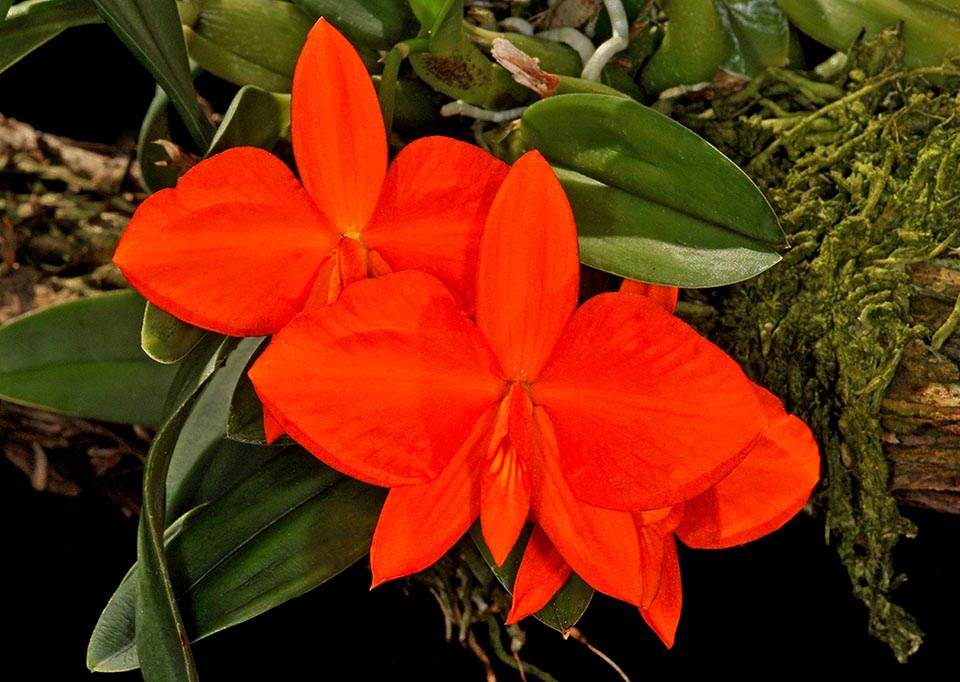
‘Marsh Hollow’ Cattleya coccinea is a clone spontaneously appeared in cultivation © Ron Parsons
Unlike Hooker, he has hastened to send it to the botanist John Lindley (1799-1865) who immediately described it as Cattleya labiata Lindl. (1824) thus creating a new genus he rightly honoured to Sir Cattley.
Since then the Cattleya entered the collecting because of the beauty of their flowers, very colourful and large, getting the name of “Queens of the orchids”.
This spectacular flower became even a sort of distinctive sign of the English noblewomen of the time who loved to show it in the buttonhole of their suits.
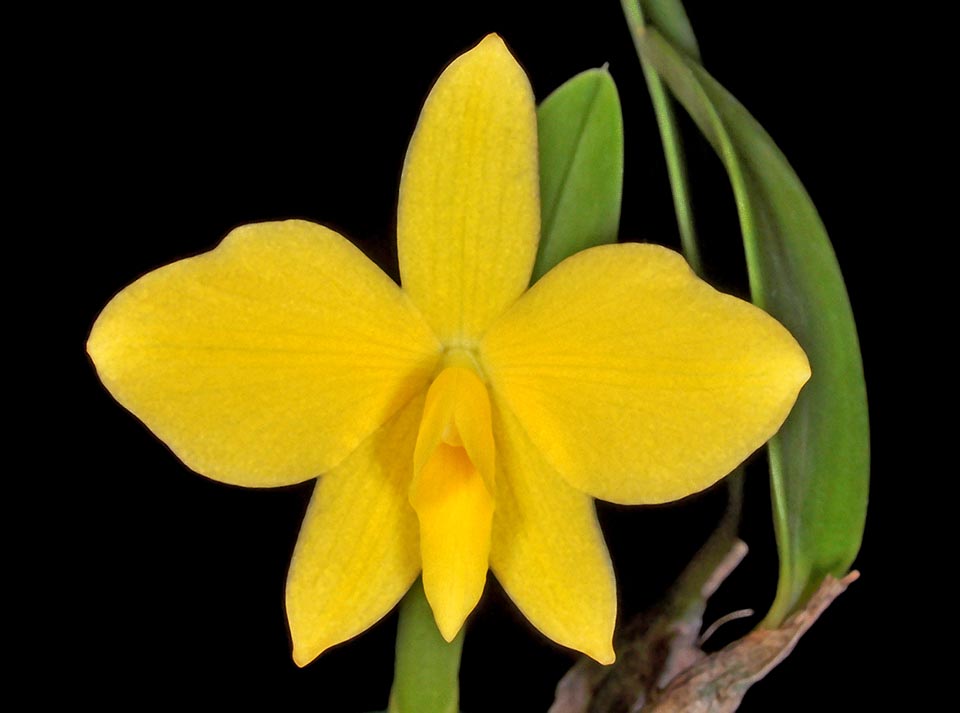
Cattleya coccinea f. flava. The yellow form very sought for by collectors is still fairly rare in cultivation © Ron Parsons
The name of the genus Cattleya, as aforementioned, comes from Sir Cattley, the specific epithet, from the Latin coccĭnus, of scarlet red colour, refers to the colour of its flowers.
It is commonly known as “Sophronite orchid” or “Scarlet Orchid”.
Cattleya coccinea is a sympodial growing plant, of small size, 8-10 cm tall, rhizomatous, with fusiform pseudobulbs, close to each other, each one with only one erect leaf, elliptic, coriaceous, about 6 cm long, of dark green colour with red central vein.
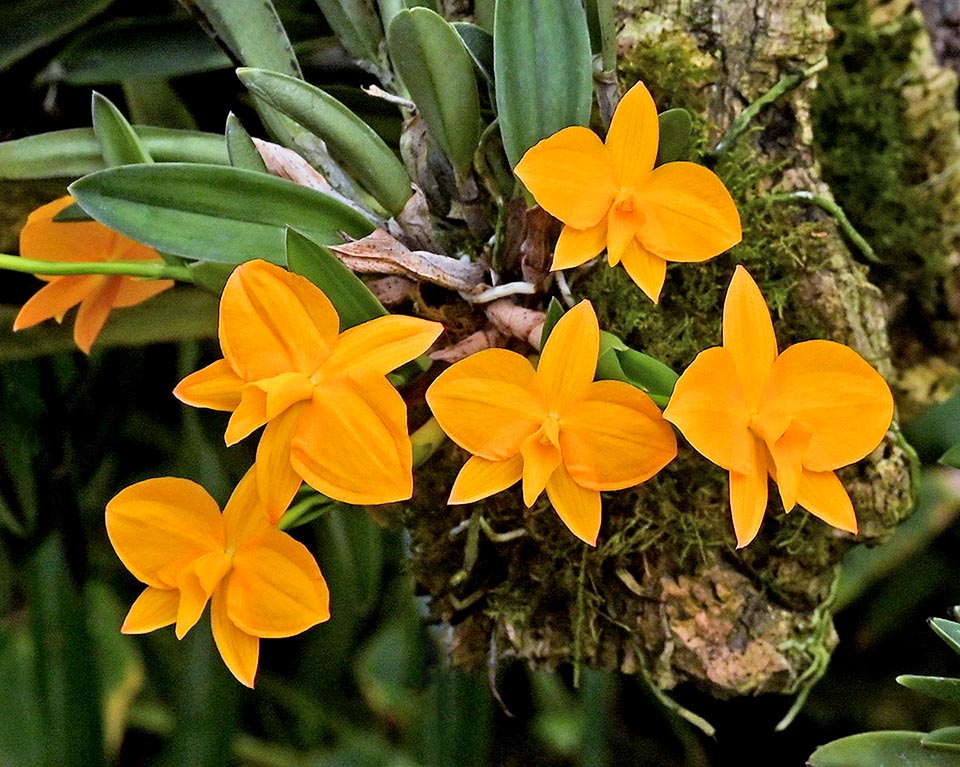
Dramatic blooming of Cattleya coccinea f. ‘Laranja’ © Ron Parsons
In order to reduce the waste of water during the winter months, the plant has adopted the photosynthesis of CAM type (Crassulacean Acid Metabolism), process that take place with closed stomata that open only during the night for the gases exchanges (CO2, 02)with a minimum waster of water vapor.
The stem of the inflorescence bears only one flower, non-fragrant, of the diametre of 5-6 cm, with rounded petals of lively red colour. The labellum is tubular, trilobed and central, with yellow to orange shades with red lines. The pollen sacs are two. Blooming occurs between late winter and early spring, and may last even more than 45 days.
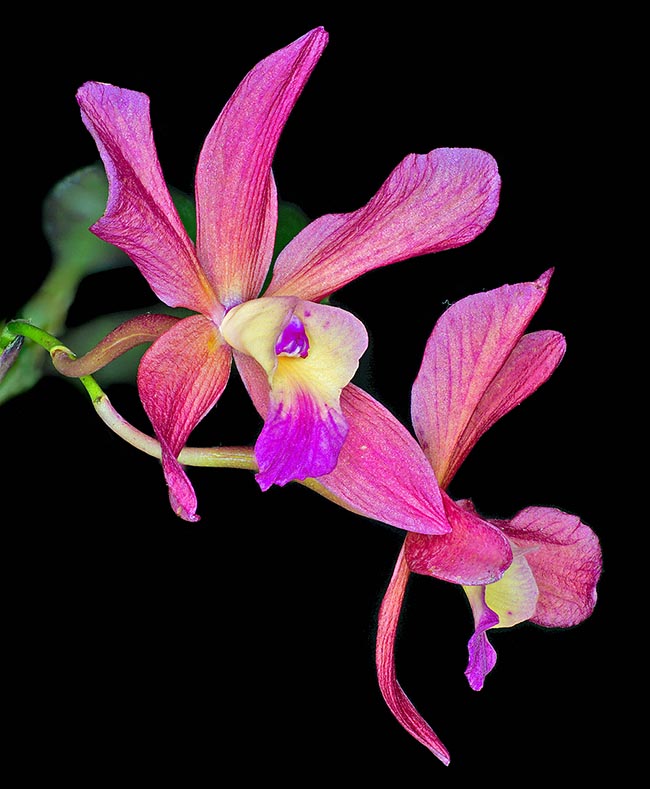
Sophrocattleya Georges Hardy comes from the crossing of Cattleya aclandiae x Cattleya coccinea © Giorgio Armano
The conformation of the flower is associated with ornithophily and it has been observed in the field that the pollination is done by the “Glittering-bellied emerald” (Chlorostilbon lucidus (Shaw, 1812), deceptively attracted, because looking for food, but receiving any reward.
Cattleya coccinea Lindl. with its luminous and scarlet flowers, is a very ornamental orchid of great interest for the collectors and the orchid growers.
Furthermore, it is very utilized for forming hybrids, because the red colour of its flowers is dominant, being kept in its descendants.
In fact, it has been much utilized by the hybridizers whe have crossed it with other species of Cattleya and of Laelia.
The hybrids obtained were respectively called × Sophrocattleya and × Sophrolaelia.
With the transfer of genus from Sophronitis to Cattleya and of some species from Laelia to Cattleya, these hybrids are nowadays classified as hybrid Cattleyae or, in some instances, as × Laeliocattleya.
Cattleya coccinea is considered as a species difficult to cultivate, suitable only for experts.
When in cultivation it requires filtered light, never direct sun, temperatures between 10 and 30 °C, high environmental humidity (about 75-80%) and good ventilation.
The substratum must be of the type suitable for epiphytic orchids (i.e. maritime pine bark), with addition of sphagnum moss to allow the moisture retention and in the meantime to guarantee its ventilation.
The plants are to be regularly irrigated, but between each watering it is good to wait for the substratum to slightly dry up in order not to let the roots rot.
The fertilization must be done with soluble organic products for orchids but, since they are small plants, it is good to use them moderately.
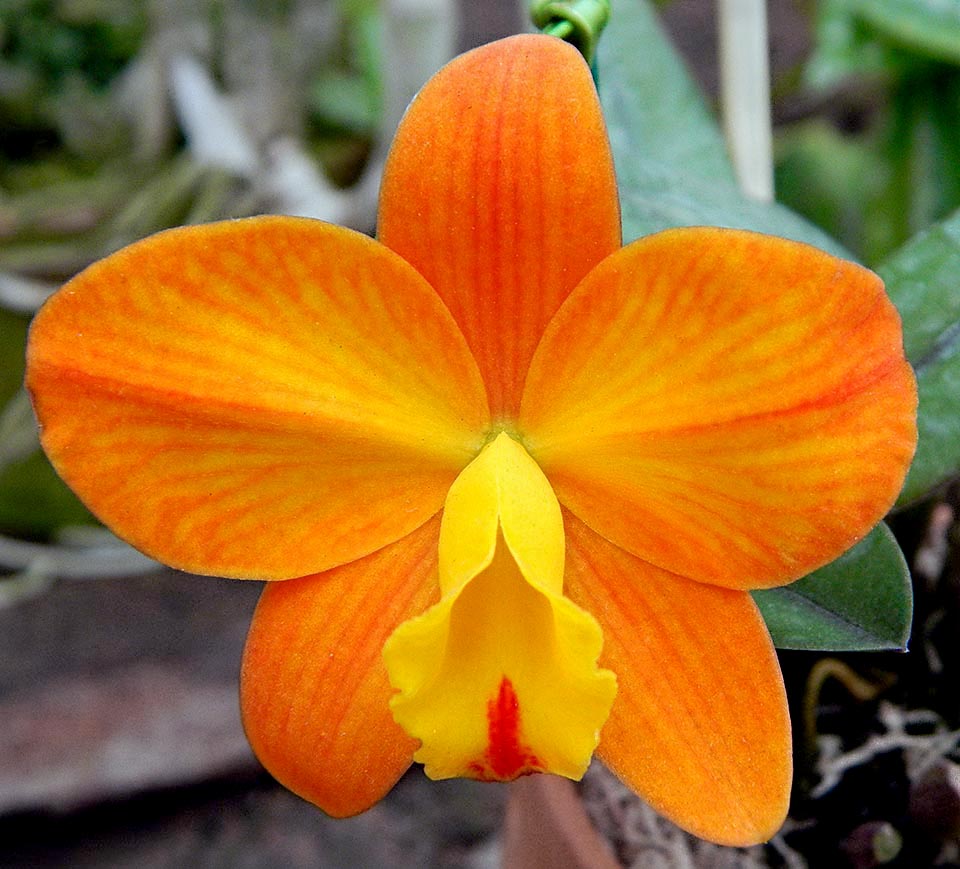
Hard to cultivate, Cattleya coccinea has originated various Cattleya and Laelia hybrids. Here Sc. Belfort x Sophronitis coccinea © Sylvio Rodrigues Pereira
The Propagation is done easily by dividing the tufts and leaving in any new small plant at least 4 mature pseudobulbs and one growing bud. Commercially this plant is multiplied in the laboratory by means of meristems or by seeds germination.
Synonyms: Sophronitis grandiflora Lindl., 1838, nom. superfl.; Cattleya grandiflora (Lindl.) Beer, 1854; Sophronitis coccinea (Lindl.) Rchb.f., 1862; Sophronia coccinea (Lindl.) Kuntze, 1891; Hadrolaelia coccinea (Lindl.) Chiron & V.P.Castro, 2002; Sophronitis militaris Rchb.f., 1862; Sophronitis rossiteriana Barb.Rodr., 1877; Sophronia militaris (Rchb.f.) Kuntze, 1891; Sophronitis coccinea f. rossiteriana (Barb.Rodr.) Pabst & Dungs, 1972; Cattleya coccinea var. rossiteriana (Barb.Rodr.) Van den Berg, 2008.
